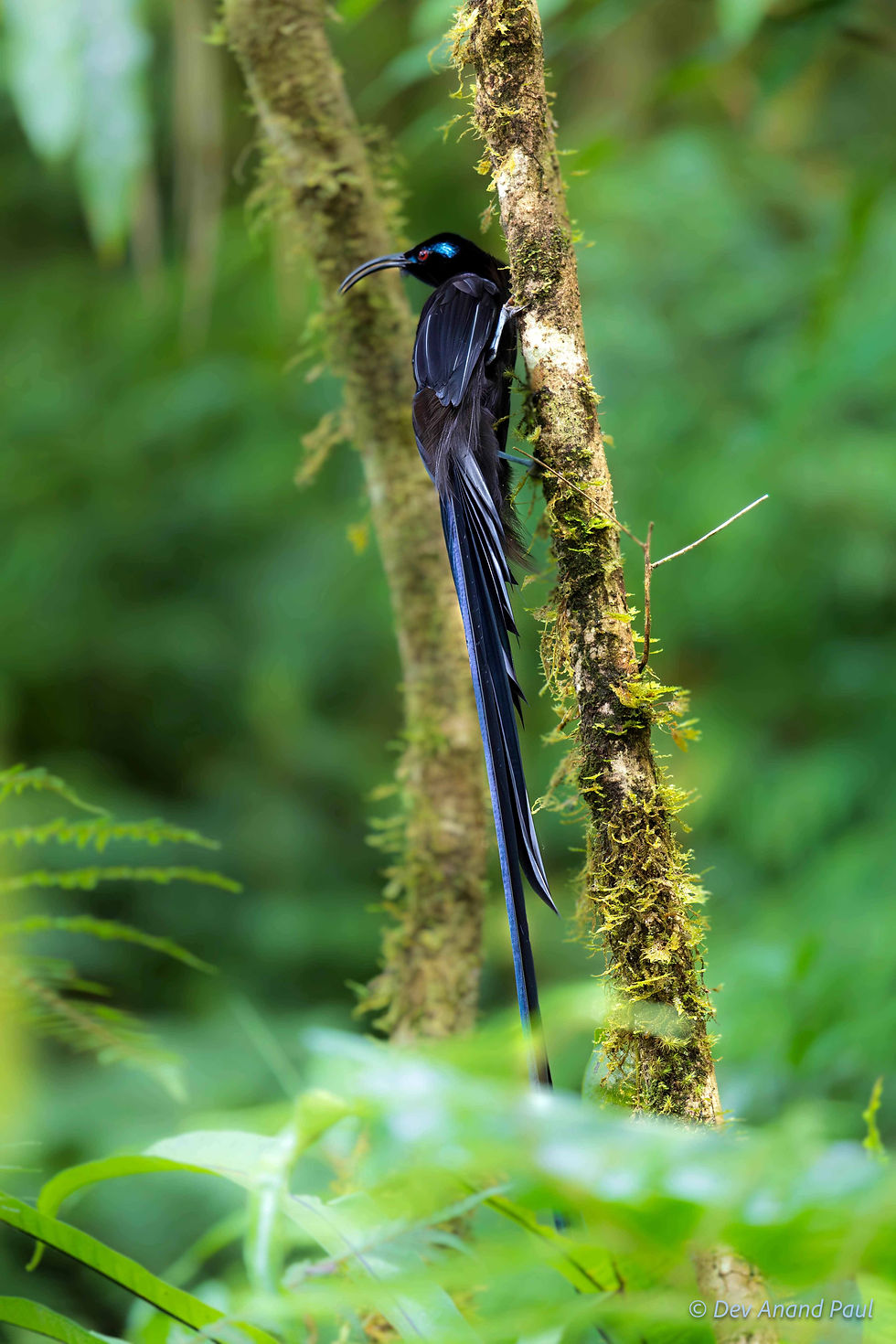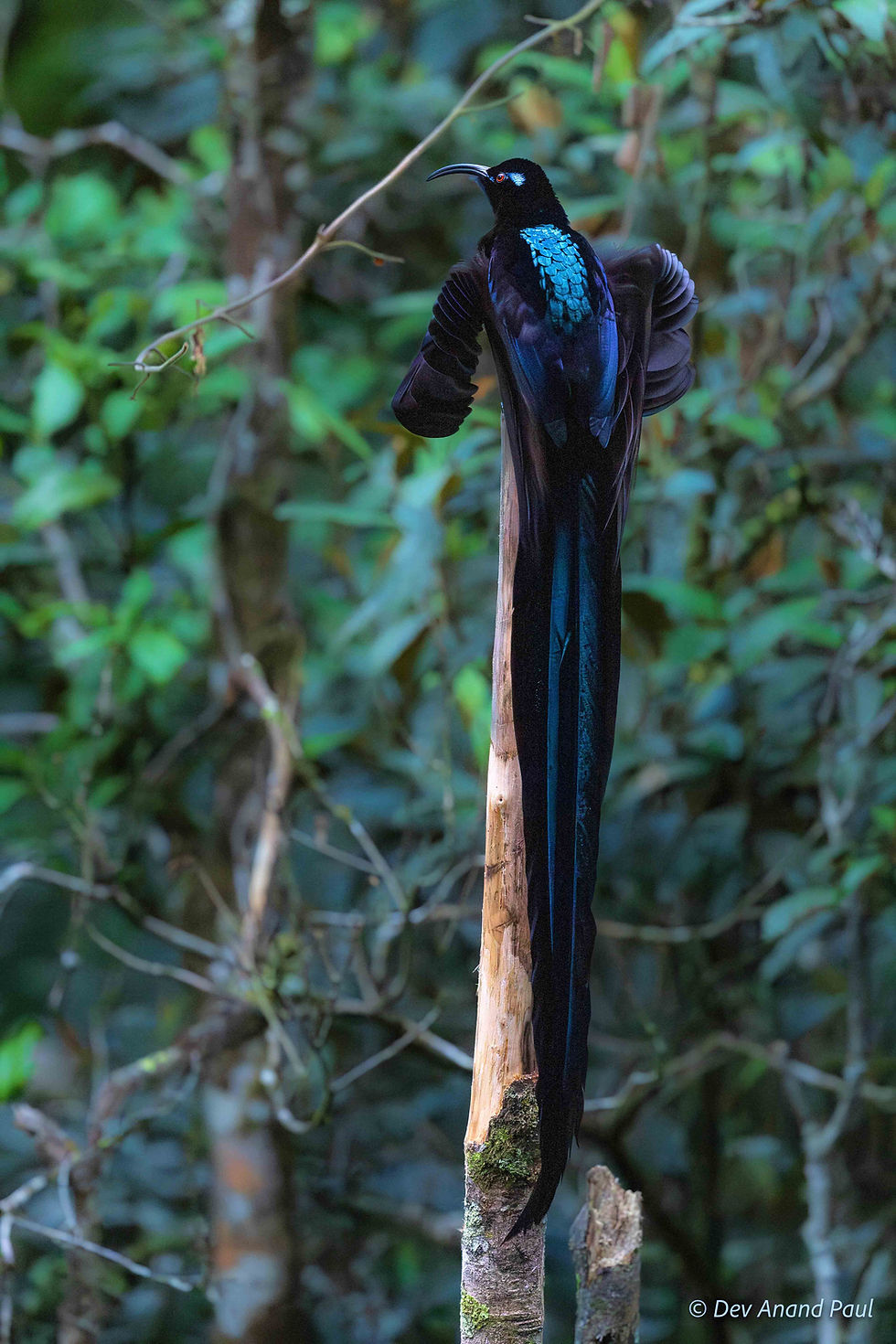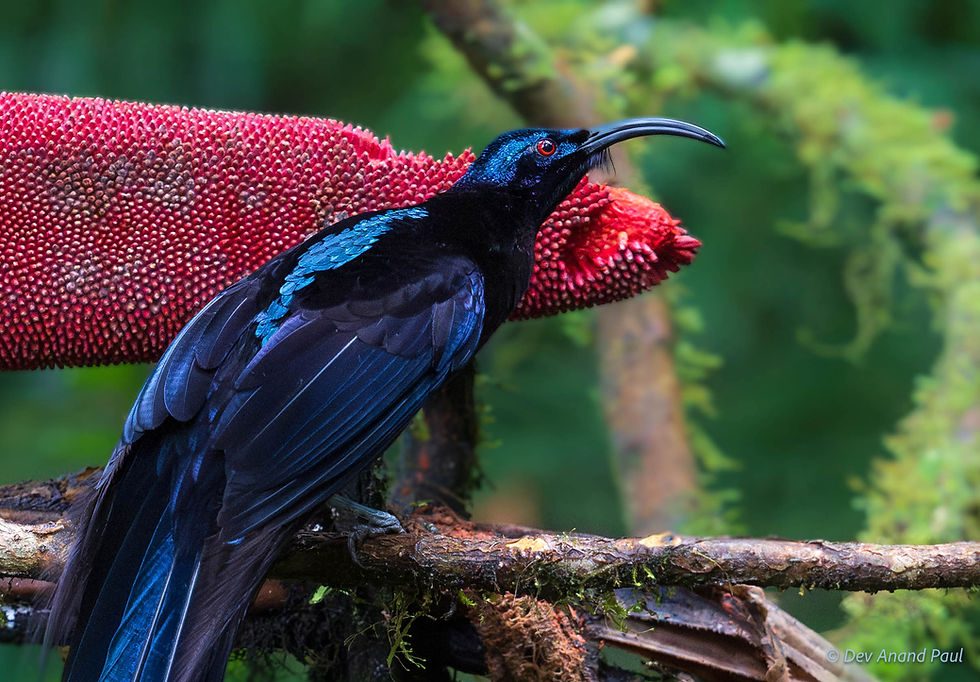Black Sicklebill Courtship Dance
- devanandpaul
- 2 days ago
- 5 min read

High on the remote mountains of New Guinea lives one of the most extraordinary birds on earth—the black sicklebill (Epimachus fastosus). To see one is rare. To watch its courtship dance is rarer still, happening in undisturbed forests between 5000 and 7000 feet; it looks like an ancient ceremony in the clouds.
Long-tailed, iridescent, and dramatic, the black sicklebill seems to be the most otherworldly of all birds of paradise. Recently, my longtime dream of sighting this bird came true: a trip to the Arfak Mountains near Manokwari, West Papua, Indonesia.
The Ascent to German Camp
German Camp is a campsite in the Arfak Mountains, known for rich biodiversity. Located at an altitude of 6562 feet, it provides access to stunning and pristine mountain rainforests and unique bird life.
The trek to the German Camp—named after a German TV crew that once set up base here to film birds of paradise—began at 4000 feet and was strenuous. The trail, slippery as soap after the rains, wound steeply upwards. With each step my boots sank deep, and I had to clutch roots and branches for balance.
Giant tree ferns arched overhead, their fronds dripping with dew. The air smelled of wet earth, with faint bursts of sweetness from unseen blossoms. And hidden birds called from shadows.

By late afternoon, after 2 hours of trekking, punctuated with slipping and catching my breath against moss-covered trunks, I reached the camp—little more than a clearing with a few makeshift shelters.
That evening, I birded near the camp: honeyeaters darting, doves cooing, parrots squabbling in the canopy. But when darkness fell, silence took over. Arfak nights are not filled with cicada songs or frog croaks. They are hushed, broken only by the occasional calls of distant owls. The darkness felt absolute, filled with anticipation and the promise of dawn.
Waiting in the Hide
I woke before 4:30 the next morning. The forest was still, the world not yet awake. A faint chill clung to the air as I set off with my guide, Demas. Equipped with headlamps, we trudged through mud and roots for 20 minutes until we reached the display site, where a small hide stood facing a bare vertical tree stump—the ‘dancing pole’ favoured by male sicklebills. I mounted my camera, steadied the tripod, and waited.

At 5:30, the forest softened from black to grey. At exactly 6:00, the silence broke.
A loud metallic call cut through the air—harsh, commanding, impossible to ignore. My heart leapt. The black sicklebill had arrived.
The Courtship Display
He descended like a winged shadow, landing squarely on the pole. Nearly 110 centimetres from beak to tail, he loomed long and sleek. In the dim light, he appeared unremarkable at first. But then he shifted, and magic spilled out: flashes of iridescent blue, green, and purple rippled across his feathers like oil on water. His long, sickle-shaped tail caught the dawn light.

He slowly, deliberately unfurled his pectoral fans (flank feathers—elongated, stiff, hornlike, and fully black, tipped with iridescent bluish-green—serving as an ornament) to his sides, and gave out a sharp tak-tak-tak, like machine-gun fire echoing through the forest.

Then, straightening his body, he raised his flank feathers up around his head, forming an ovoid ring, with only his curved beak sticking out. After which he leaned to the side and bobbed up and down, transforming from a bird-like form into a horizontal comet shape on his perch. It forms a thin, continuous iridescent blue band by a precise lining up of the flank feathers.

The cycle repeated. For 10 minutes he danced with tireless conviction, as if the forest itself were his audience.
However, no female responded. So, he folded his plumes and vanished into the canopy.
But the morning show wasn’t finished.
A Rival Appears
Barely 15 minutes had passed when another call echoed. A second male descended on the display pole—younger, perhaps less polished, but determined. He launched into the same ritual: stretching his pectoral fans to his sides, changing into a comet form, pivoting and bobbing, straightening, repeat.
His display lasted longer, around 15 minutes. Although his movements lacked the fluid grace of the first bird and his plumes spread unevenly, his calls were louder, almost desperate. I wondered whether females noticed such subtleties, whether these tiny flaws meant the difference between rejection and success.
Still no female in sight. He, too, gave a final rasping cry and disappeared into the forest.
The stage fell silent again.
The Female’s Choice
Unlike the flamboyant male, the female black sicklebill is modest—smaller, brown, and finely barred for camouflage. She performs heavier duties: building the nest, laying eggs, raising the chicks, all alone.

And it is she who picks her partner. She perches quietly, hidden in the foliage, watching as males perform. Only if impressed will she descend to accept the male.

A Bird Born of Excess
The black sicklebill is nature’s extravagance. His long tail and pectoral plumes make flying harder and increase his risk of predation. Yet these very burdens make him desirable. His dance is both gamble and boast: I survive despite this beauty. Choose me, and our offspring will be strong.
Evolution’s artistry balanced on a knife edge.

Fragile Kingdom
The Arfaks remain one of the last refuges of the black sicklebill. Here, the forests endure, spared from the chainsaw because of their altitude and remoteness. These birds were once threatened by hunting as well—their plumes were prized for headdresses; today, however, thanks to eco-tourism, a living bird brings more value than a dead one does.

But it is a delicate balance—too much tourism, and the birds may abandon their sites; too little, and the old pressures return.
The Descent
By late morning, the forest grew hotter. I began my descent, boots often skidding. In daylight, the trail looked ordinary, stripped of its dawn mystery.
But inside me something stayed. I carried not just photographs but a memory etched deep: the metallic call, the shimmer of feathers in half-light, the vision of a bird transforming into a comet shape.

Why Do I Travel Far to See Birds?
That night, sitting outside my hut on the Arfak mountain, I asked myself: Why? Why climb slippery slopes, endure aching muscles, rise before dawn, just to wait for a glimpse of a bird?
The answer, I realized, has many layers.
I travel as a seeker of beauty, because a sicklebill’s dance is creation’s purest art.
I travel as a storyteller, to share images with those who may never set foot here.
I travel as a pilgrim, offering sweat and struggle in exchange for fleeting moments of beauty.
I travel as a witness, knowing forests and birds may not always last.
But above all, I travel because I cannot stop. Like Ulysses in Tennyson’s lines, I feel that restless hunger:
I cannot rest from travel: I will drink
Life to the lees
The old mariner’s call (in Tennyson’s poem ‘Ulysses’)—‘to strive, to seek, to find, and not to yield’—echoes in my bones.

Birds like the black sicklebill remind me that life is too rich to be lived from an armchair. They don’t dance for us, yet we go—climbing, waiting, hoping—because we long to witness something rare, fragile, and beautiful.
Travel, then, is not an escape to me. It is to keep moving, to keep seeking, to keep drinking from the cup of wonder until the very end.
Related posts:




Beautiful read ! Lovely pictures and video. Keep exploring new places and share your experiences with the world through your writings.